Where, Oh Where Can They Be?
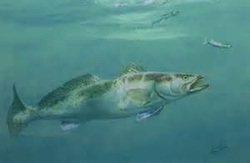
In Part 1 of Capt. Toney's presentation to us, we learned how to rig our rods and reels to target Spotted Seatrout. In Part 2, we learned about all of the different bait and lure options we had to choose from, which ones he recommended and why. Finally, in Part 3, he taught us how the seasons affect the trout bite and how to recognize potential 'hot-spots' where trout might be hanging out.
He began by explaining to us that trout are low-light feeders. Because of the location of their eyes on their head, they tend to always be looking upward and will ambush unsuspecting bait fish from below. So optimal conditions for trout fishing will be during an incoming tide early in the morning or incoming tide late in the afternoon. On bright sunny, windless days you won't find them feeding as much between those times because of the intensity of the sun beating down through the water. They will feed more aggressively on overcast days or breezy, windy days when the water's surface is broken up a bit. It's easier on their eyes.
He began by explaining to us that trout are low-light feeders. Because of the location of their eyes on their head, they tend to always be looking upward and will ambush unsuspecting bait fish from below. So optimal conditions for trout fishing will be during an incoming tide early in the morning or incoming tide late in the afternoon. On bright sunny, windless days you won't find them feeding as much between those times because of the intensity of the sun beating down through the water. They will feed more aggressively on overcast days or breezy, windy days when the water's surface is broken up a bit. It's easier on their eyes.
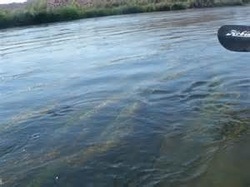
If you look closely at the picture to the left, you'll notice a type of kelp grass under the water and flowing in the direction of the current. This type of grass is sometimes called 'rock grass' because it adheres to hard bottom. It grows all through the summer and is one of the trout's favorite hang outs because it's like a grass forest that they can hide in. Capt. Toney suggested using a top-water lure here, for obvious reasons, and take a good 15-20 minutes to fish these areas because even if you sneak up on them in a quiet kayak, they may not bite immediately. Patience is your best friend here. In the Capt.'s words: "Being impatient blows opportunities" At low tide, rock grass is easy to spot, but if you come across a patch at high tide, the water will cover it so mark it on a GPS unit, that way you'll be able to find it again next time you fish the same general area. Again, good spot for shade during the hot summer (sunny) months.
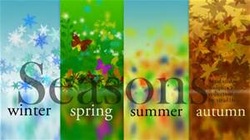
Speaking of hot summer days... There are different ways to target trout depending on the seasons. The optimal water temperature for trout is approximately 68 - 74 degrees.
We'll start with the months of February, March and April. During these months the Nature Coast waters are still pretty cold and we often have late season cold fronts blow in unexpectedly. During low tide you can see limestone rock sticking up out of the water. This exposed rock will absorb as much heat from the mid-day sun as it can before the tide comes in and covers it again. That rock still stays warm under water for a little while longer and trout will seek these spots out to warm themselves. Try fishing areas like this during the incoming tide. Compared to the rest of the year, trout have a little bit more spunk to 'em when you're catch them on light tackle during these transition months. When those rocks are covered at high tide, they've lost all of their warmth and the trout have moved back into deeper holes where the water may not be as warm but it's a stable temperature and they'll congregate there in higher concentrations.
As spring moves into summer, you'll be looking at shallow water on windless days. Capt. Toney suggested that we lighten up our tackle a bit during these months. No heavy jig-heads plopping in the water. This would be a great time to try that DOA 5.5 inch glow colored jerk bait that he showed us in Part 2 of our meeting. This lure is a little heavier than most soft plastics which makes it easier to cast farther, thereby covering more ground....er....water. The Capt. explained that this lure will hit the water lightly and the loop knot will allow it to 'wiggle' through the water during the reeling-in process. Use a little 'twitch' action every now and then, too.
As the summer gets hotter, the shallow waters will get hotter, too. This is when trout will move out to deeper, cooler waters. If you're so inclined to follow them out there and find 'em, here's how you go about doing that: Hypothetically you'll be in about 8-12 feet of water. This is a system Capt. Toney called "Dragging", basically trolling for trout. Use a 1/8 oz jig-head and a bait color of either rootbeer, new penny or electric chicken. Color will make a difference in this instance and if you can get any of these colors with a gold flake added, do it. Cast behind you and as you drift with the wind or current, your bait will drag behind moving at the same pace. This is actually a good way to catch trout in deeper water.
Targeting trout in the late, hot summer months, like August for instance, will be a different story all together. Just like people, the dog-days-of-summer leaves them with little energy. The water heats up inshore and they're off to find deeper cooler temperatures. That's not to say that you can't catch them inshore, though. You know those late summer thunder storms that roll through on a daily basis and dump an hours worth of rain? They are the catalyst that'll change conditions. Cooler water temperatures will follow, welcoming trout to return to the flats to feed for a while. Fish for a few hours after one of these afternoon rain storms and approaching sunset. These overcast conditions will trigger fish bites.
As Fall approaches, it'll bring a nice change of pace from the hot, steamy months of summer. What's also different is that Capt. Toney noticed that the typical trout bite on incoming tide seems to reverse during the months of September and October. He's noticed a trend during these months where the trout bite is more numerous during the outgoing tide and said that he catches more trout using a top-water lure during this time of year. These are the lures that will attract larger, more aggressive fish.
Then, of course, comes the dreaded winter! This is the time of year when trout will head in one of two ways, either into the deeper parts of rivers like the Withlacoochee or into King's Bay where the water temperature is fairly regulated by the springs, or they'll go in the complete opposite direction and head out into the deeper parts of the Gulf (20-30 feet or so). Quick temperature drops on the flats will freeze them out so it's their survival mechanism that sends them running when their bodies feel that permanent temperature change coming on. So if you're targeting trout in the winter, look for the deeper areas (holes, channels, canals, etc.) and also look for dark bottom areas. Remember, dark colors absorb heat (that's why we wear dark colors in the winter) and dark water bottoms do the same. Find the 'hot-spots' you'll find fish, too. This will be a good time to use a jig-head - to get your bait to the bottom, where the fish are.
We'll start with the months of February, March and April. During these months the Nature Coast waters are still pretty cold and we often have late season cold fronts blow in unexpectedly. During low tide you can see limestone rock sticking up out of the water. This exposed rock will absorb as much heat from the mid-day sun as it can before the tide comes in and covers it again. That rock still stays warm under water for a little while longer and trout will seek these spots out to warm themselves. Try fishing areas like this during the incoming tide. Compared to the rest of the year, trout have a little bit more spunk to 'em when you're catch them on light tackle during these transition months. When those rocks are covered at high tide, they've lost all of their warmth and the trout have moved back into deeper holes where the water may not be as warm but it's a stable temperature and they'll congregate there in higher concentrations.
As spring moves into summer, you'll be looking at shallow water on windless days. Capt. Toney suggested that we lighten up our tackle a bit during these months. No heavy jig-heads plopping in the water. This would be a great time to try that DOA 5.5 inch glow colored jerk bait that he showed us in Part 2 of our meeting. This lure is a little heavier than most soft plastics which makes it easier to cast farther, thereby covering more ground....er....water. The Capt. explained that this lure will hit the water lightly and the loop knot will allow it to 'wiggle' through the water during the reeling-in process. Use a little 'twitch' action every now and then, too.
As the summer gets hotter, the shallow waters will get hotter, too. This is when trout will move out to deeper, cooler waters. If you're so inclined to follow them out there and find 'em, here's how you go about doing that: Hypothetically you'll be in about 8-12 feet of water. This is a system Capt. Toney called "Dragging", basically trolling for trout. Use a 1/8 oz jig-head and a bait color of either rootbeer, new penny or electric chicken. Color will make a difference in this instance and if you can get any of these colors with a gold flake added, do it. Cast behind you and as you drift with the wind or current, your bait will drag behind moving at the same pace. This is actually a good way to catch trout in deeper water.
Targeting trout in the late, hot summer months, like August for instance, will be a different story all together. Just like people, the dog-days-of-summer leaves them with little energy. The water heats up inshore and they're off to find deeper cooler temperatures. That's not to say that you can't catch them inshore, though. You know those late summer thunder storms that roll through on a daily basis and dump an hours worth of rain? They are the catalyst that'll change conditions. Cooler water temperatures will follow, welcoming trout to return to the flats to feed for a while. Fish for a few hours after one of these afternoon rain storms and approaching sunset. These overcast conditions will trigger fish bites.
As Fall approaches, it'll bring a nice change of pace from the hot, steamy months of summer. What's also different is that Capt. Toney noticed that the typical trout bite on incoming tide seems to reverse during the months of September and October. He's noticed a trend during these months where the trout bite is more numerous during the outgoing tide and said that he catches more trout using a top-water lure during this time of year. These are the lures that will attract larger, more aggressive fish.
Then, of course, comes the dreaded winter! This is the time of year when trout will head in one of two ways, either into the deeper parts of rivers like the Withlacoochee or into King's Bay where the water temperature is fairly regulated by the springs, or they'll go in the complete opposite direction and head out into the deeper parts of the Gulf (20-30 feet or so). Quick temperature drops on the flats will freeze them out so it's their survival mechanism that sends them running when their bodies feel that permanent temperature change coming on. So if you're targeting trout in the winter, look for the deeper areas (holes, channels, canals, etc.) and also look for dark bottom areas. Remember, dark colors absorb heat (that's why we wear dark colors in the winter) and dark water bottoms do the same. Find the 'hot-spots' you'll find fish, too. This will be a good time to use a jig-head - to get your bait to the bottom, where the fish are.
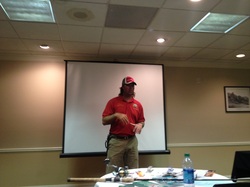
After Capt. Toney gave us an overview of his basic seasonal trout tactics, he gave us a few other pieces of advice that just didn't seem to fit into any one of the earlier topics. One of which was about slack line. So often he'd have clients on his boat who've hooked into a nice size trout that ended up wiggling itself free before it was reeled to the boat. Totally preventable! One of the trout's instinctive moves is to run once it realizes something's wrong (that would be the hook in its mouth). All too often that trout runs in the direction of the confused angler which causes the line to go slack. This slack line, in turn, gives the angler the false impression that he lost the fish (when, in fact it's still on the hook and heading under the boat). Unfortunately, that same slack line gives the fish enough room to loosen the hook and shake free of it. A trout's mouth is very soft and easy to rip and that hook, within a matter of seconds, can create enough room through friction in a trout's mouth to dislodge itself with the help of a spunky fish trying its best to "get this thing off me". If you're lucky, you'll feel the line tighten again once it's made it to the other side of the boat and you realize then that you never lost the fish to begin with. Want to avoid that scenario altogether? Capt. Toney said, "As soon as you feel the tug on your line, set the hook slowly. You can yank a hook right out of a trout's mouth if you try to set it too quickly. Then - reel - reel - reel and keep your rod tip high. Don't give it any room to wiggle that hook out .If you do have a trout on, it's the best way to ensure that you get it to the boat.
Secondly, trout will sometimes have 'soft takes' which means that they have larger than average mouths and can engulf a piece of bait or lure without the angler ever feeling the strike so it's important to pay attention to all possible strikes. Try an experiment when you feel frustrated out there. Cast out, then close your eyes. Pay attention to the feel of the rod and line. A small strike may not feel like much at first, but you may have a big-un on the line.
Secondly, trout will sometimes have 'soft takes' which means that they have larger than average mouths and can engulf a piece of bait or lure without the angler ever feeling the strike so it's important to pay attention to all possible strikes. Try an experiment when you feel frustrated out there. Cast out, then close your eyes. Pay attention to the feel of the rod and line. A small strike may not feel like much at first, but you may have a big-un on the line.
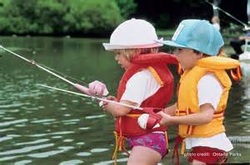
Our time with Capt. Toney came to an end at around 8:00 p.m. He really spent so much time with us explaining different aspects of targeting the Spotted Seatrout and teaching us what lures and tactics work best in his opinion. But at the end of the day, he told us not to take fishing too serious or get too frustrated out there on the water. Every day should be an enjoyable learning experience. We were all anxious to get back out on the water and try out some of his ideas. But, he had a little surprise for us before we ended out meeting.
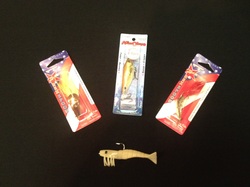
Capt. Toney brought a hand full of his favorite trout lures to introduce us to over the course of the evening and when he was done with his presentation, he surprised us by giving each of those lures away. We handed him a container with our names in it and the lucky winners were:
Dot - won the glow colored DOA 3" shrimp
Marilee - won the MirrOmullet topwater lure
Martha Ann - won the Eppinger copper original Rex spoon with the chartreuse feather
Theresa - won the Eppinger gold original Rex spoon with the red feather
Sue - won the MirrOlure C17MR Suspending Twitchbait
Dot - won the glow colored DOA 3" shrimp
Marilee - won the MirrOmullet topwater lure
Martha Ann - won the Eppinger copper original Rex spoon with the chartreuse feather
Theresa - won the Eppinger gold original Rex spoon with the red feather
Sue - won the MirrOlure C17MR Suspending Twitchbait
 RSS Feed
RSS Feed